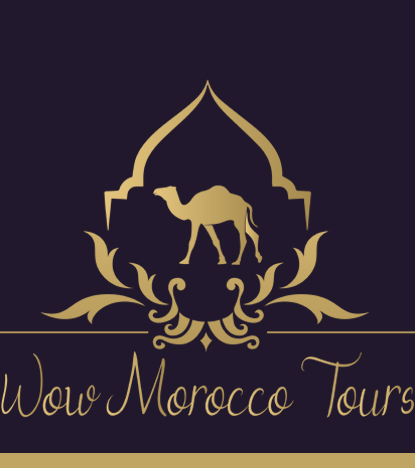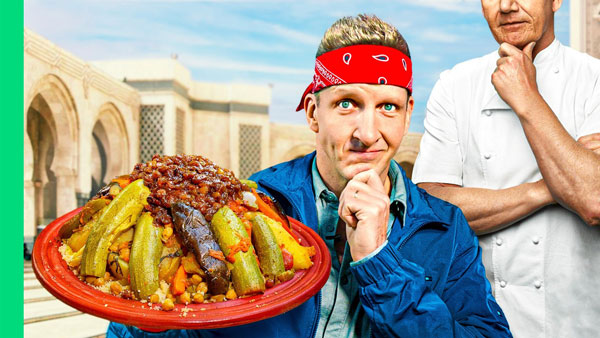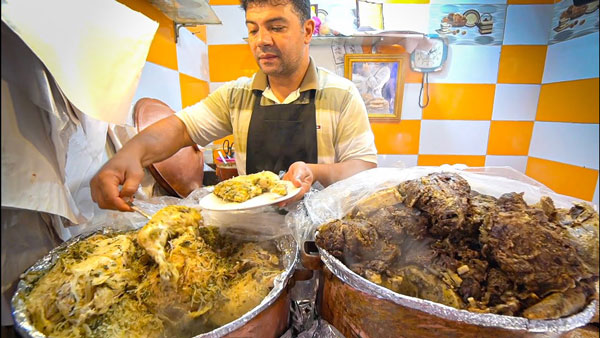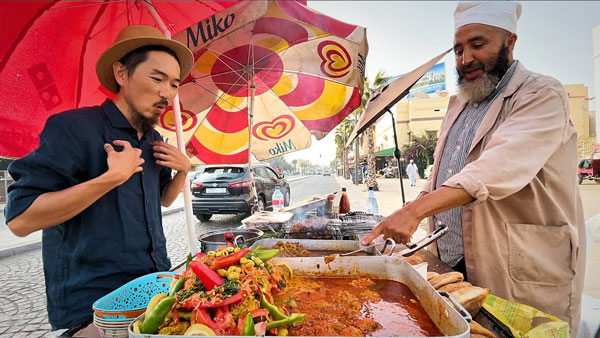
Top Traditional Moroccan Cuisine Recipes and Street Food
Introduction to Moroccan Cuisine:
Moroccan cuisine is a culinary tapestry woven from centuries of cultural exchange, trade, and tradition. Nestled at the crossroads of Africa, Europe, and the Middle East, Morocco has developed a food culture that is as diverse as its landscape ranging from the snow-capped Atlas Mountains and sweeping Sahara Desert to the vibrant coastal cities along the Mediterranean and Atlantic. Each bite tells a story of Berber ingenuity, Arab sophistication, French refinement, and sub-Saharan warmth.
At the heart of Moroccan cooking lies a love for spices—cumin, cinnamon, saffron, paprika, ginger, and the iconic ras el hanout, a blend that can include up to 30 different spices. These ingredients transform simple meals into aromatic feasts that awaken all the senses. Traditional Moroccan dishes are often slow-cooked, layered with flavor, and steeped in communal rituals that reflect the country’s deep-rooted hospitality. Meals are not just about eating—they’re about sharing, gathering, and celebrating.
But Moroccan food culture is not confined to the family table or the ornate dining halls of riads. The streets of Morocco bustle with vendors serving up a wide variety of local favorites—each with its own regional twist. From the smoky scent of grilled brochettes to the comforting warmth of bissara (fava bean soup), street food is where you’ll find the pulse of daily Moroccan life. Whether you’re wandering through the labyrinthine alleys of Fes or people-watching in a Casablanca market, you’re never far from a quick, delicious, and affordable bite.
In this article, we’ll take you on a flavorful journey through the traditional dishes that form the backbone of Moroccan cuisine and the vibrant street food that keeps locals and visitors coming back for more. From the royal simplicity of couscous to the fiery kick of maakouda, prepare to explore a culinary heritage that is as rich and varied as Morocco itself.
Famous Traditional Moroccan Cuisine Recipes
Moroccan Tagine
Tagine is arguably the most iconic dish in Morocco, both in terms of its distinctive cooking method and the rich variety of ingredients it brings together. The name “tagine” refers to both the pot—an earthenware vessel with a conical lid—and the dish itself. The pot’s design helps to lock in moisture, creating a tender, slow-cooked meal. The dish can vary widely depending on the region and available ingredients. Common versions include chicken tagine with preserved lemons and olives, lamb tagine with prunes, and beef tagine with apricots and almonds.
What makes tagine so unique is the marriage of savory and sweet flavors, often enhanced with an aromatic mix of spices such as saffron, cinnamon, ginger, and turmeric. The dish’s complexity lies not only in its seasoning but in the slow-cooking technique that infuses every ingredient with flavor. Whether served with couscous, bread, or alone, tagine remains a central part of Moroccan culinary tradition.
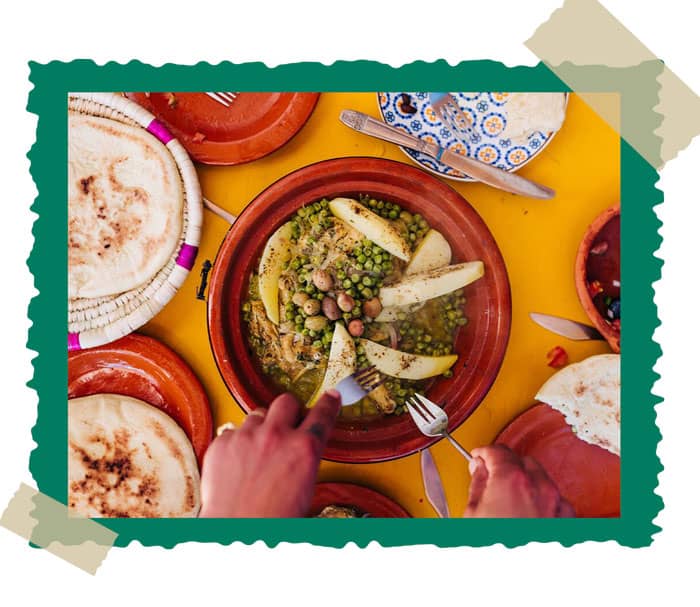
Moroccan Couscous
Couscous is the cornerstone of Moroccan food culture and is often the star of large family gatherings, especially on Fridays. Couscous consists of small steamed balls of semolina wheat, often paired with a stew of lamb, chicken, vegetables, and chickpeas. The preparation of couscous is a meticulous, multi-step process that involves steaming the semolina in a special couscoussière (a double-tiered steaming pot). The couscous is traditionally steamed three times for the perfect texture, ensuring that the grains are fluffy and light.
The dish is typically served with a rich, flavorful stew made from the meat of choice (commonly lamb or chicken), vegetables such as carrots, zucchini, and turnips, and legumes like chickpeas. It’s not only a filling and comforting dish but also a symbol of hospitality, often prepared for large groups and shared amongst family and friends.
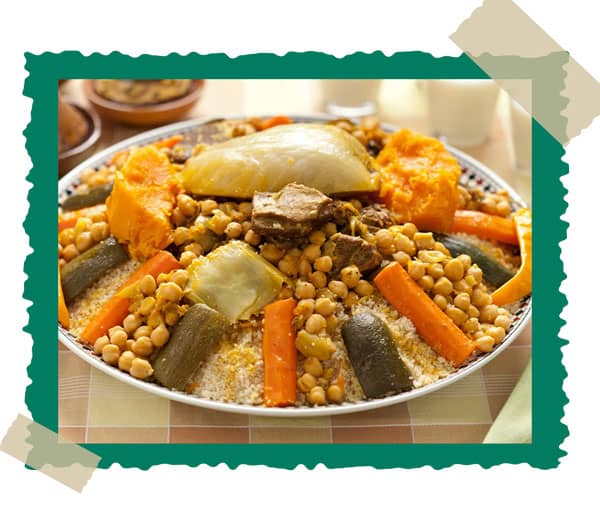
Moroccan Harira
Harira is the quintessential Moroccan soup, rich and hearty, often enjoyed during Ramadan to break the fast. This deeply flavorful soup combines tomatoes, lentils, chickpeas, and tender pieces of meat—usually lamb or beef—cooked in a broth spiced with coriander, ginger, turmeric, and cinnamon. A traditional recipe includes a touch of flour, which helps to thicken the soup, creating a luxurious, velvety texture.
Harira is often paired with dates, bread, or sfiha (savory pastries) as part of a well-rounded meal. The soup’s origins can be traced back to Moroccan Andalusian influences, where it was seen as both a nourishing and comforting meal to provide sustenance after a long day of fasting. Harira is a reflection of Moroccan ingenuity, as it provides both protein and hydration, making it a complete meal in a bowl.
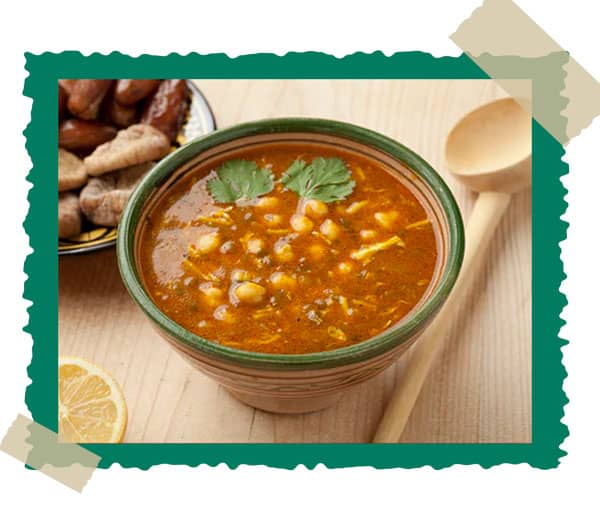
Moroccan Pastilla (Bastilla)
Pastilla is a showstopper of Moroccan cuisine—a pastry that cleverly combines sweet and savory in a single, delicate package. This dish is traditionally made with pigeon, though chicken is more commonly used today, and it’s seasoned with a unique blend of cinnamon, saffron, ginger, and sometimes orange blossom water. The filling is then encased in layers of warqa (Moroccan pastry dough, similar to filo) and baked until golden and crisp.
The most striking feature of pastilla is the contrast between its flaky exterior and the complex flavors inside, with tender meat, almonds, and eggs forming a delicate, spiced custard. It’s often finished with a dusting of powdered sugar and cinnamon, offering a sweet counterpoint to the savory filling. Pastilla is often reserved for special occasions, including weddings and large family feasts, making it an emblem of Moroccan hospitality and celebration.
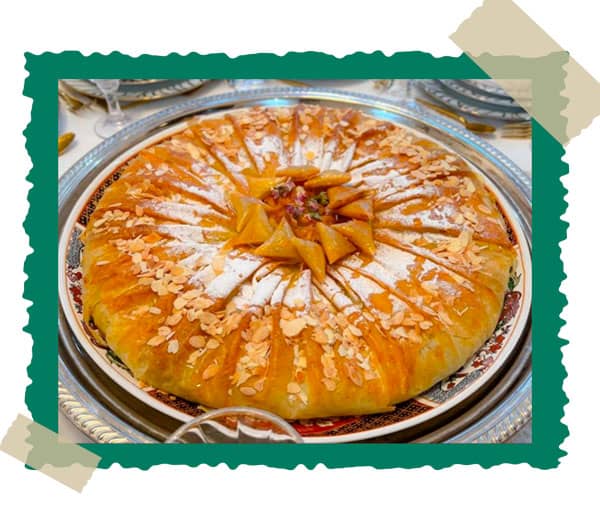
Moroccan Mechoui
Mechoui is a quintessential Moroccan feast that involves roasting a whole lamb or mutton in a traditional clay oven or pit. This method of cooking is done slowly over several hours, ensuring the meat becomes incredibly tender and infused with smoky flavors. The lamb is typically seasoned simply with cumin and salt, letting the quality of the meat shine through.
Mechoui is a communal dish, often served at large gatherings or celebrations, where the lamb is carved and shared by all. It’s a dish that highlights the Moroccan appreciation for simple yet profoundly flavorful food, and it’s typically paired with flatbread, fresh herbs, and a variety of salads.
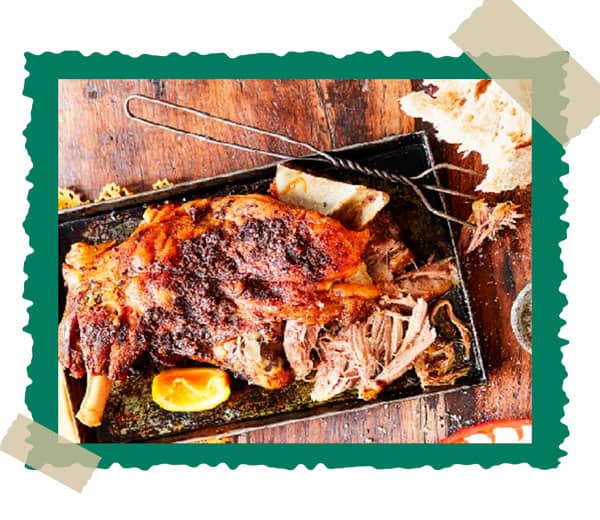
Moroccan Rfissa
Rfissa is a deeply comforting and nourishing Moroccan dish that is often prepared for special occasions or to honor new mothers. It features shredded msemen (a Moroccan flatbread similar to pancakes), which is soaked in a rich, spiced chicken broth. The dish is flavored with a fragrant mix of fenugreek, saffron, and ras el hanout—an iconic Moroccan spice blend.
While rfissa’s ingredients may seem simple, the dish is a labor of love, with the bread, broth, and chicken all coming together to form a rich, hearty meal. Traditionally, it is served to postpartum women, as it’s believed to help restore strength and energy. Rfissa is a quintessential example of the Moroccan philosophy of food as medicine and nourishment for both the body and soul.
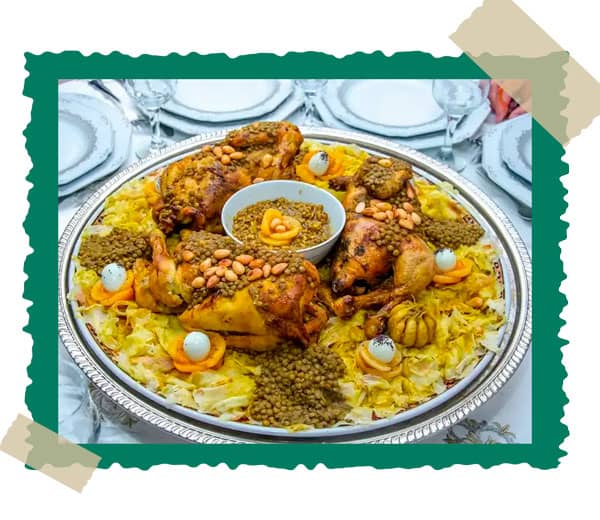
Moroccan Bissara
Bissara is a humble yet delicious soup made from dried fava beans, which are slowly simmered until they break down into a smooth, creamy consistency. The soup is typically flavored with garlic, cumin, and a drizzle of high-quality olive oil, and often served with a sprinkling of chili for those who enjoy a bit of heat.
This dish is particularly popular in colder regions of Morocco and is commonly enjoyed as a filling breakfast or lunch. Bissara is traditionally served with warm bread, which is used to scoop up the soup, making it a hearty and satisfying meal that reflects the simplicity and depth of Moroccan home cooking.
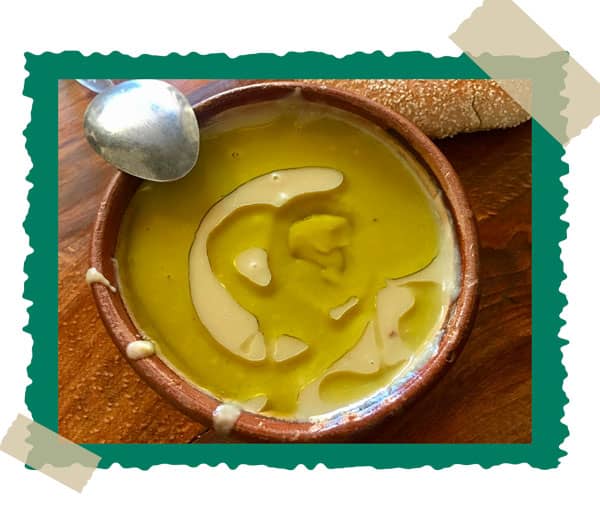
Ready to Explore the Rich Flavors of Moroccan Cuisine?
From the fragrant aroma of slow-cooked tagines to the delicate sweetness of honey-drenched pastries, Moroccan cuisine is a journey through centuries of tradition and vibrant flavors. Discover the stories behind iconic dishes, savor the perfect blend of spices, and immerse yourself in a culinary adventure like no other. Whether you’re a street food enthusiast or a fine dining connoisseur, the tastes of Morocco are calling — and it’s time to take the first bite.
Top Moroccan Street Food
Moroccan street food is a true reflection of the country’s bustling, vibrant culture. It’s where locals and visitors alike gather, savoring quick, flavorful bites that combine the rich culinary heritage of Morocco with the excitement of street life. From busy medinas to seaside promenades, Morocco’s street food scene is brimming with aromas, colors, and textures that invite you to experience the essence of Moroccan flavor in its most casual, accessible form. Here’s a deeper look into some of the most beloved street food dishes that have become an integral part of Morocco’s culinary landscape:
Sfenj (Moroccan Doughnuts)
Sfenj is Morocco’s answer to doughnuts, though the traditional recipe is simpler and less sweet than what you might expect from Western-style pastries. These deep-fried dough balls are made from a dough similar to that of a yeast bread, which gives them a light and airy texture. Typically served hot, sfenj is often enjoyed for breakfast or as a snack, dusted with powdered sugar or dipped in honey.
The dough is deep-fried until golden brown, creating a crispy exterior and a soft, chewy interior. Vendors can be found in bustling squares or at street corners, where the enticing scent of freshly fried sfenj wafts through the air. It’s often paired with a cup of Moroccan mint tea, creating a delightful balance of sweetness and herbal refreshment.
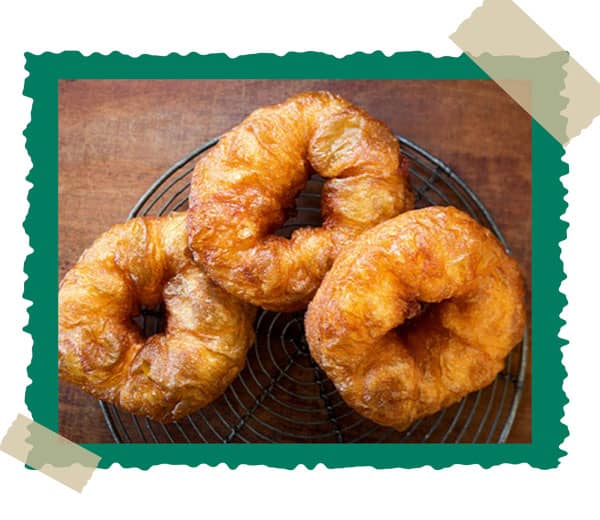
Brochettes (Grilled Skewers)
Brochettes are a popular street food in Morocco, especially in cities like Marrakech and Fes, where you’ll find vendors grilling skewers of marinated meat right in front of you. The meat, often lamb, beef, or chicken, is marinated in a mixture of cumin, paprika, garlic, and other spices before being skewered and grilled over an open flame. The result is tender, juicy meat with a smoky flavor that is both rich and satisfying.
Brochettes are usually served with flatbread, a fresh salad, and a sprinkling of spices. Some vendors even offer additional toppings like spicy harissa or a squeeze of lemon, adding an extra layer of heat and zest. Whether you’re strolling through the bustling Djemaa el-Fna square or enjoying a seaside sunset in Essaouira, brochettes are a quick and flavorful bite that captures the heart of Moroccan street food.
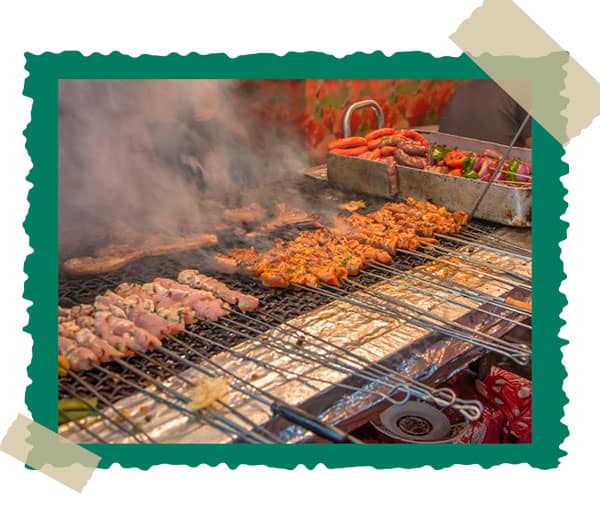
Maakouda (Moroccan Potato Cakes)
Maakouda is a beloved Moroccan street snack made from mashed potatoes, spices, and fresh herbs. These golden-brown potato cakes are deep-fried to crispy perfection, creating a crunchy exterior with a soft, fluffy interior. The potatoes are seasoned with cumin, garlic, parsley, and coriander, giving them a fragrant and savory flavor.
Often served as a quick snack, maakouda is typically enjoyed with a squeeze of lemon or a side of spicy sauce. It’s a popular choice for breakfast, lunch, or as a light snack throughout the day, and can sometimes be found at street food stalls alongside other Moroccan treats. Whether eaten alone or paired with a brochette, maakouda is a comforting and satisfying choice that reflects Morocco’s love of bold, hearty flavors.
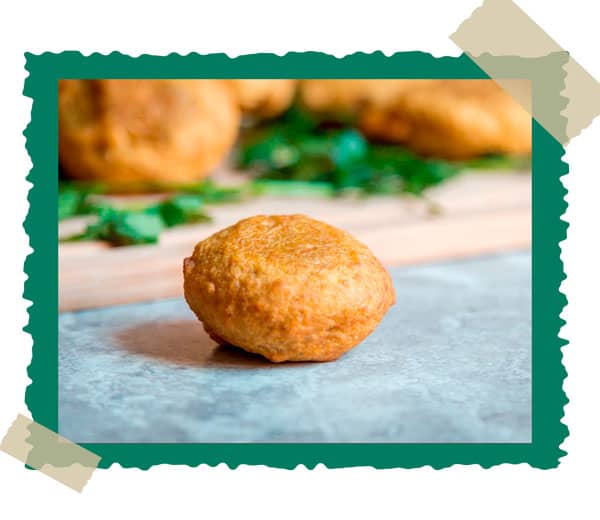
MSEMEN(Moroccan Flatbread)
Msemen is a flaky, square-shaped flatbread that is a favorite snack or breakfast in Morocco. The dough is made with semolina, flour, and a generous amount of butter, creating a soft, pillowy texture with a slightly crispy exterior. Msemen can be enjoyed plain, or stuffed with fillings such as onions, meat, or cheese.
The dough is rolled and folded multiple times before being pan-fried, resulting in layers that puff up during cooking. Msemen is often served with honey, olive oil, or jam and can also be enjoyed with Moroccan mint tea. This versatile dish can be eaten any time of day and is frequently served at street food stalls, where it is made fresh to order, filling the air with its delicious aroma.

Snails (Babouche)
Snails, or babouche in Moroccan Arabic, are a surprisingly popular street food, especially in cities like Marrakech, where vendors sell them from steaming pots on street corners. The snails are typically boiled in a flavorful broth made from herbs, garlic, and spices such as cumin, ginger, and saffron. The broth is rich and aromatic, designed to infuse the snails with deep, savory flavors.
Eating snails in Morocco is an interactive experience—using a small wooden pick, you extract the snails from their shells and dip them into the broth. While the texture might seem unusual to some, the combination of tender snail meat and spiced broth is a unique and flavorful experience. Often enjoyed as a warm, satisfying snack, babouche is considered both a delicacy and a remedy for cold weather, as it’s believed to have health benefits.
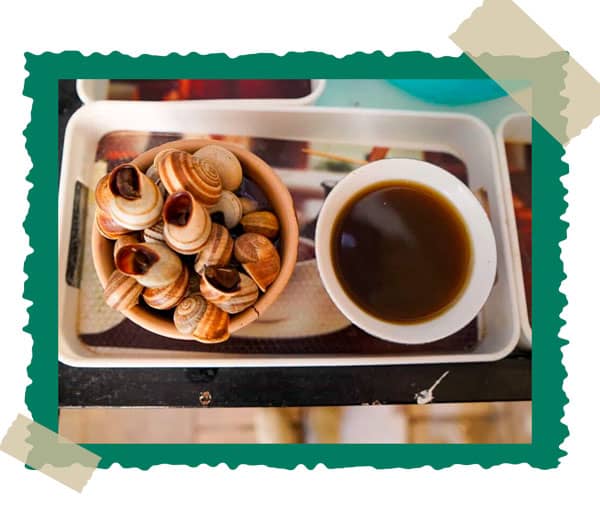
Baghrir (Moroccan Pancakes)
Baghrir, also known as “thousand-hole pancakes,” are light, spongy pancakes that are often served as a breakfast or snack. The batter is made from semolina and yeast, which gives the pancakes their distinctive airy texture. When cooked, the batter forms tiny holes on the surface, making them look unique and adding to their soft, delicate texture.
Baghrir is typically served with honey and butter, though you may also find it drizzled with olive oil or sprinkled with sugar, depending on the region. In larger cities, vendors often offer them on the streets, served fresh and hot. Their comforting, slightly tangy flavor and light texture make them a perfect way to start the day or enjoy as an afternoon snack.
Moroccan street food offers a wide range of flavors, textures, and experiences, from the crispy, fried sfenj to the aromatic snails served in spiced broth. Each dish tells a story of Moroccan culture and hospitality, offering a taste of the country’s culinary soul. Whether you’re snacking on msemen in the morning or enjoying grilled brochettes in the evening, street food in Morocco is a delightful way to engage with the country’s rich food traditions.
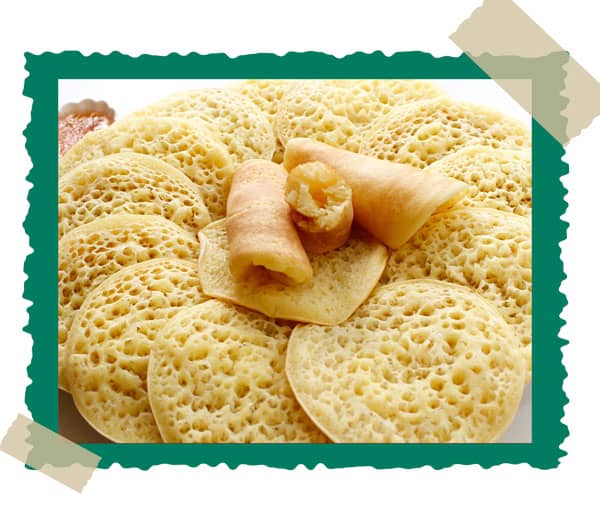
Ready to Explore the Rich Flavors of Moroccan Cuisine?
From the fragrant aroma of slow-cooked tagines to the delicate sweetness of honey-drenched pastries, Moroccan cuisine is a journey through centuries of tradition and vibrant flavors. Discover the stories behind iconic dishes, savor the perfect blend of spices, and immerse yourself in a culinary adventure like no other. Whether you’re a street food enthusiast or a fine dining connoisseur, the tastes of Morocco are calling — and it’s time to take the first bite.
Famous Moroccan Chefs
Morocco’s culinary tradition is rich, complex, and varied, and many of its chefs have become renowned figures both within the country and internationally. These chefs have not only mastered traditional Moroccan recipes but have also contributed to the evolution of Moroccan cuisine in the global culinary landscape. Their creativity, passion for flavor, and dedication to preserving the authentic tastes of Morocco have earned them respect from food lovers around the world. Let’s explore some of the most famous Moroccan chefs who have made their mark in the culinary world.
Chef Mourad Lahlou
Mourad Lahlou is one of the most internationally celebrated Moroccan chefs, known for his innovative approach to traditional Moroccan dishes. A native of Marrakesh, Chef Lahlou is the chef-owner of the restaurant Aziza in San Francisco, which has earned Michelin stars for its modern take on Moroccan cuisine. Lahlou has worked tirelessly to modernize Moroccan food, blending its rich history with contemporary techniques.
He is best known for reimagining Moroccan classics, such as tagine and couscous, by using ingredients and techniques that give the dishes a modern, sophisticated twist. His approach involves emphasizing the bold flavors of Morocco’s spices while maintaining the authenticity of the dishes. Chef Lahlou has also written a cookbook, Mourad: New Moroccan, where he shares his recipes and insights into the unique flavors of Moroccan cooking.
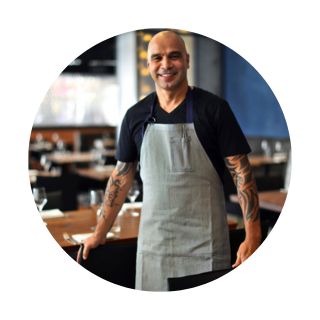
Chef Najat Kaanache
Chef Najat Kaanache is another influential figure in the world of Moroccan cuisine. Born in the vibrant city of Casablanca, Chef Kaanache has become renowned for her ability to blend traditional Moroccan flavors with a modern culinary approach. Having trained in top kitchens around the world, she is known for her role as the executive chef at Dar Yacout in Marrakesh, where she elevates Moroccan dishes to a refined, contemporary level.
Chef Kaanache’s work is celebrated for its creativity and respect for the integrity of Moroccan ingredients, often reinterpreting classic dishes while maintaining their essence. She has garnered international recognition for her dedication to Moroccan cuisine and continues to share her knowledge and passion through culinary workshops and media appearances.

Chef Choumicha Chafay
Choumicha Chafay is one of Morocco’s most beloved chefs and food television personalities. Known for her cooking shows and popular YouTube channel, Choumicha has played a significant role in promoting Moroccan food to a global audience. With her warm, approachable style, she makes Moroccan cuisine accessible to viewers and home cooks alike.
Choumicha has also authored several cookbooks, which showcase a wide array of traditional Moroccan recipes. Her passion for sharing the intricacies of Moroccan cooking has made her a household name, and her influence extends far beyond Morocco, with her shows being broadcast in various countries. She remains an ambassador for Moroccan food, helping to elevate the cuisine on the global stage.

Chef Moha Fedal
Chef Moha Fedal is a prominent Moroccan chef known for his focus on reinventing traditional Moroccan dishes. A master of both Moroccan and Mediterranean cuisines, Chef Fedal’s culinary career has taken him to some of the finest kitchens, where he brings a contemporary twist to classic Moroccan flavors. Chef Fedal is passionate about showcasing local Moroccan ingredients while adding a modern flair to the presentation and preparation of dishes.
His flagship restaurant, Le Tobsil, in Marrakesh, has become famous for its impeccable cuisine and beautiful atmosphere. Chef Moha Fedal is celebrated for his commitment to authenticity while embracing new culinary trends and techniques. His ability to create a perfect harmony between the old and new has made him a respected figure in Moroccan gastronomy.
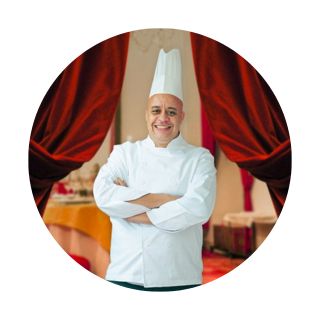
Chef Meryem Cherkaoui
Chef Meryem Cherkaoui is a celebrated Moroccan chef known for blending Moroccan and French cuisine. Her unique approach to fusion cooking has earned her acclaim in some of the world’s top restaurants, and she is considered a respected ambassador of Moroccan gastronomy. Chef Cherkaoui’s dishes showcase her exceptional talent for combining the delicate flavors of Morocco with French culinary techniques, creating exquisite and award-winning dishes.
Chef Cherkaoui’s innovative approach has led her to work in prestigious culinary institutions and share her expertise at international food festivals. Her ability to merge the best of both culinary worlds has helped elevate Moroccan cuisine’s reputation on the global stage.
Moroccan chefs have become true ambassadors of their cuisine, each bringing their unique perspective and expertise to the global food scene. Whether through television appearances, Michelin-starred restaurants, or culinary workshops, these chefs have ensured that the flavors of Morocco continue to thrive and inspire chefs and food lovers around the world.
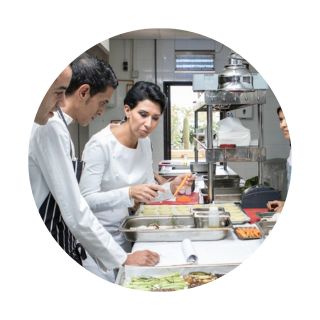
Tourists and Famous Chefs’s Reactions (Reviews) on Moroccan Food
⭐⭐⭐⭐⭐
Moroccan cuisine is a major highlight for travelers exploring the country, offering a vibrant blend of flavors, spices, and textures. From the bustling souks to the tranquil coastal towns, tourists from all over the world come to Morocco to experience the unique culinary traditions that have been passed down through generations. The food here is often described as an unforgettable journey, where each dish tells a story of culture, history, and hospitality.
Let’s take a look at some of the common reactions and reviews from tourists and international chefs who have had the pleasure of indulging in Moroccan food:
Sonny Side’s Moroccan Food Experience
Sonny Side is a world-renowned British chef, restaurateur, and television personality, known for his fiery temper, culinary expertise, and multiple Michelin stars. His program “Food Country in the World?? I Put it to the Test!” showcases Ramsay traveling around the globe to explore and test the best culinary traditions from various countries, offering a unique, hands-on experience of different cuisines. He challenges local foods and cooking techniques, providing both entertainment and insight into the rich flavors and cultures around the world.
And this is his review about the Moroccan cuisine: Ramsay dives deep into the vibrant flavors of Moroccan food, highlighting the country’s unique blend of spices and fresh ingredients. He explores traditional dishes like tagine, couscous, and pastilla, offering his expert opinion on their authenticity and execution. Through his lens, Moroccan cuisine is revealed as a stunning reflection of the country’s diverse history and rich cultural heritage.
Morocco’s culinary reputation has reached new heights, and if you’ve ever wondered why, just ask the tourists who have tasted its flavors firsthand. Here’s what they had to say:
“A Journey Through Time in Fez”
Wandering the labyrinthine alleys of Fez felt like stepping back in time. The scent of preserved lemons, smoky grilled meats, and freshly baked bread filled the air, mingling with the distant hum of artisans hammering copper and weaving carpets. I tried the iconic khobz (traditional Moroccan bread) baked in a 17th-century communal oven. The bread, with its slightly woody aroma and perfectly crisp crust, became my edible spoon as I dove into rich tagines and vibrant couscous dishes. It’s more than food here – it’s a story on a plate, a connection to centuries of tradition.
“Tasting Tradition in a Tajine”
My first taste of a real Moroccan tajine was in a small, unassuming eatery tucked away in the heart of Marrakech. The slow-cooked lamb and vegetables, simmered in a sauce bursting with saffron, ginger, and preserved lemons, left me in awe. The tajine’s conical lid locked in all the flavors, creating a self-basting miracle of spices, lemon, and olive oil. Every bite was a reminder of why this dish is beloved worldwide – tender, aromatic, and deeply comforting.
“Couscous – More Than Just a Dish”
Couscous Fridays are a cherished tradition here, and I had the privilege of joining a local family for this iconic meal. Layers of fluffy, steamed couscous were topped with a mountain of root vegetables, caramelized onions, and tender chunks of lamb, all drenched in a rich, aromatic broth. The combination of savory, sweet, and slightly nutty flavors was something I never imagined. It’s a true celebration on a plate, a dish that brings families together in the spirit of community.
“The Sweet Surprise of Pastilla”
One of the most surprising dishes I tried was pastilla, a flaky pastry filled with spiced pigeon, eggs, and almonds, dusted with cinnamon and powdered sugar. It’s a flavor explosion – sweet, savory, crunchy, and tender all at once. I never thought I’d enjoy pigeon, but this dish completely changed my mind. It felt like a royal treat, a perfect blend of French and Moorish influences that truly represents Morocco’s rich culinary history.
“Home-Cooked Hospitality”
The highlight of my trip was a home-cooked Rfissa – a dish of shredded flatbread soaked in a rich chicken stew, topped with caramelized onions, almonds, and dates. It’s traditionally served on special occasions, but the family I visited welcomed me as if I were one of their own. This experience captured the warmth and hospitality that make Moroccan cuisine unforgettable. Sitting around a shared platter, eating with our hands, and exchanging stories felt like a celebration of life itself.
Final Thoughts – Is it the Best in the World?
From the ancient streets of Fez to the bustling markets of Marrakech, I’ve tasted the soul of Moroccan cuisine, and I can see why it’s considered one of the best. It’s not just about the food – it’s about the hospitality, the history, and the artistry of every dish. If you ever find yourself in Morocco, prepare your taste buds for a journey like no other.
Luke Martin Tastes Moroccan Street Food
Luke Martin is a popular food and travel vlogger known for his YouTube channel “Luke Martin – Chopstick Travel”. He explores street food, traditional dishes, and local culinary cultures from around the world. His videos often feature authentic food experiences, highlighting lesser-known spots and giving viewers an immersive taste of global cuisine.
And this is his review of Moroccan cuisine:
If there’s one place in the world where flavor, culture, and hospitality come together in perfect harmony, it’s Morocco. As a foodie and an avid traveler, I recently had the chance to explore this North African culinary paradise — and let me just say, Morocco completely blew me away. From the snow-capped High Atlas Mountains to the rolling dunes of the Sahara Desert, I discovered a food scene as vibrant and diverse as its landscapes.
Here’s a taste (pun intended) of my unforgettable street food journey across Morocco.
Zaza Smoothie: A Sweet, Creamy Start
We kicked things off at a bustling juice stand with Morocco’s famous Zaza smoothie. Imagine a giant avocado milkshake topped with Oreos, bananas, strawberries, nuts, and flan — yes, flan! It looked wild, but the flavor? Even wilder. Sweet, creamy, and indulgent, it was the perfect start to our food trek.
Berber Pizza (Madfouna): The Sahara’s Hidden Gem
Next, we hit the desert for the legendary Madfouna, also known as Berber Pizza. This wasn’t your average slice — it’s a stuffed flatbread, one version filled with beef and spices, the other with veggies and boiled eggs. Cooked in a desert oven and sliced like a pizza, it was juicy, spiced to perfection, and deeply satisfying. A must-try!
Herbal Tea: A Moroccan Ritual
Herbal tea in Morocco isn’t just a drink — it’s a ritual. I sipped on a brew packed with mint, sage, verbena, and more, served in a traditional metal pot. It was sweet, earthy, and potent — easily the most intense tea I’ve ever had.
Pickle Cocktail: A Tangy Surprise
Pickled eggplant, potatoes, beets, and even a splash of beet juice? Yes, please. This street-side pickle cocktail hit all the right notes — tangy, spicy (thanks to a dash of harissa), and surprisingly delicate.
Snails in Broth: A Flavor Bomb
Snails in Morocco are serious business. Served in a rich, spicy broth, they were chewy, smooth, and packed with herbal flavor. Honestly, I came for the novelty, but I stayed for the broth — it was THAT good.
Fresh Camel Milk: Creamy and Comforting
Trying warm camel milk straight from the source was definitely a first. It tasted surprisingly similar to cow’s milk but richer and creamier, with a touch of sweetness.
Bisara Soup: A Breakfast Favorite
Thick, creamy, and swimming in olive oil, Bisara (a fava bean soup) is a breakfast staple. Add garlic, cumin, and chili on top, and you have a warm, spicy hug in a bowl.
Moroccan Sweets: A Sticky Heaven
From jalebi-like spirals to almond-filled phyllo dough triangles drenched in honey and cinnamon, Morocco is a dreamland for anyone with a sweet tooth.
Couscous Royale: Fit for Royalty
A traditional Friday couscous meal featured tender chicken and beef, root veggies like beets, pumpkin, and turnip, all resting on the fluffiest couscous I’ve ever tasted. Every bite told a story of generations.
Grilled Trout with Harissa: Smoky Perfection
Wrapped in foil with rosemary, Moroccan spices, and olive oil, the trout was grilled to juicy perfection. Paired with a spicy harissa dip, it melted in my mouth.
Cow and Lamb Head Sandwich: Not for the Faint of Heart
This was one of the more adventurous bites — meat straight from a cow and lamb head, chopped and seasoned with cumin and chili, stuffed into a crusty roll. It was fatty, chewy, and surprisingly tasty.
Meat Skewers with Aged Butter (Smen): Smoky and Rich
Lamb, beef, and chicken skewers dipped in aged, salted butter (smen) — smoky, savory, and juicy. One bite and I understood why this combo is legendary in Marrakech.
Halawa Sweets: Traditional Moroccan Nougat
These hand-cut nutty candies were light, crunchy, and not overly sweet. A perfect snack while wandering the ancient streets of Fez.
Caliente Chickpea Pie: Simple Street Snack
Served with cumin and cut fresh from a roadside cart, caliente was soft, eggy, and mildly flavored — a warm and humble little snack.
Oysters and Seafood Feast: Fresh from the Atlantic
At the seaside, we devoured fresh oysters, grilled sardines, buttery sea bass, crab and avocado salad, calamari, and garlic shrimp. Everything was ocean-fresh, beautifully seasoned, and bursting with flavor.
Camel Meat and Back Fat: Surprisingly Tender
Camel tongue, back fat, and meat all steamed to perfection. The texture was soft, and the flavor was oddly reminiscent of roast beef — mild, fatty, and totally delicious.
Makuda & Fried Sardines: Street Sandwich Masterpiece
We tried the ultimate street sandwich — fried sardines stuffed with herbs, mashed potato balls (makuda), harissa, and eggplant. Spicy, crunchy, and rich — it hit all the flavor notes.
Stuffed Beef Spleen: A Fez Specialty
Stuffed with minced meat, liver, spices, and olives, then roasted — this dish was like nothing I’ve ever seen or tasted. It’s a bold dish for the adventurous eater, but surprisingly delicious.
Chicken Tagine: The National Treasure
Tender chicken simmered with potatoes, Moroccan spices, and olives in a clay tagine. It was warm, flavorful, and deeply aromatic. Pure comfort food.
Khlii Omelet: Fatty, Savory, Unforgettable
Moroccan breakfast includes khlii, preserved meat cooked in its own fat. Served in an omelet, it was salty, fatty, and absolutely delicious. I don’t know what Andrew Zimmern was thinking — this stuff is amazing!
Final Thoughts: Morocco is a Culinary Wonderland
From savory to sweet, adventurous to familiar, Morocco served up one of the most diverse and flavorful food tours I’ve ever experienced. Every city brought something new, every vendor had a story, and every bite was unforgettable.
If you’re a foodie or just curious about world cuisine, Morocco belongs on your bucket list. And trust me — go with an empty stomach
Discover the story – watch now !
Ready to Explore the Rich Flavors of Moroccan Cuisine?
From the fragrant aroma of slow-cooked tagines to the delicate sweetness of honey-drenched pastries, Moroccan cuisine is a journey through centuries of tradition and vibrant flavors. Discover the stories behind iconic dishes, savor the perfect blend of spices, and immerse yourself in a culinary adventure like no other. Whether you’re a street food enthusiast or a fine dining connoisseur, the tastes of Morocco are calling — and it’s time to take the first bite.
Exploring Moroccan Cuisine with Bohemian Family
Mino and Amina are travel and food content creators who share their culinary adventures through their YouTube channel, often referred to as the Bohemian Family. Their videos focus on authentic street food, traditional dishes, and immersive cultural experiences in each country they visit. With a warm and friendly style, they aim to connect with locals and explore the heart of food culture wherever they go.
And this is their review of Moroccan cuisine — a delicious journey through the vibrant food scene of Agadir, where they try everything from grilled meats and stuffed beef spleen to artisan burgers, seafood feasts, and the famous Amlou spread.
Discovering Agadir Through Its Incredible Street Food: A Culinary Tour with Mino & Amina
Peace be upon you, Bohemian Family! We’re Mino and Amina, and today we want to take you with us on a mouth-watering food journey through the beautiful coastal city of Agadir, Morocco.
Agadir, nestled along Morocco’s southern Atlantic coast, is not only known for its stunning beaches and laid-back vibe—it’s also a hidden gem for food lovers. From sizzling grilled meats to fresh seafood, artisan burgers, and traditional Moroccan sweets, the flavors of Agadir left us both speechless and stuffed!
Grilled Goodness: Moroccan Teppanyaki Street Style
One of our first stops was a popular Moroccan-style teppanyaki street vendor. The air was filled with the irresistible aroma of sizzling meat—beef kefta, liver, marinated turkey, and beef heart all grilled to perfection.
You can get your meat as a plate or tucked into a crusty sandwich. We tried chewy beef heart, sweet liver, and juicy kefta with caramelized onions and tomato sauce. We even combined all three and topped it off with spicy Harissa—a total flavor bomb!
Street Food Surprises: Sardines, Fishballs & Tehan
Next, we stumbled upon a bustling corner offering Moroccan fish sandwiches. We tried everything from spicy sardine fishballs in tomato chili sauce to beef tripe and the incredibly flavorful Tehan—stuffed beef spleen with herbs, garlic, and fat. This dish quickly became one of our favorites!
What made it special wasn’t just the taste—it was the experience. Locals offered us onion, pickled chili, and Moroccan ketchup with warm smiles and hospitality. One street chef here definitely deserves the title of “Hidden Gem of Agadir.”
A Sweet, Spiky Treat: Prickly Pears (Hindia)
Under the Moroccan sun, we quenched our thirst with fresh cactus fruit (locally called Hindia). The vendor skillfully peeled the spiky fruits, revealing sweet, refreshing flesh with a slightly seedy texture. Prickly pear, or Berber fig, is nature’s candy—and only 1.5 MAD each!
We washed it down with a zesty drink of lemon, lime, ginger, and sugarcane—spicy, sweet, and refreshing!
Gourmet Moroccan Burgers with Masterchef Abdou
We had the honor of being invited by Masterchef Abdou, winner of Morocco’s Masterchef and owner of a gourmet burger house in Agadir.
Let us tell you—these were not ordinary burgers. The buns were homemade potato rolls, and inside: pulled beef, fried onions, jalapeños, and creamy BBQ sauce. We also tried a seafood burger with fried shrimp, fish, and guacamole.
Everything was crafted with love and precision. Abdou even makes his own cucumber pickles!
Amlou & Couscous at the Souk
Chef Abdou took us to Souk El Had, the local market, to meet Mr. Hassan, a couscous and Amlou specialist.
We saw local Agadir couscous made from five cereals, and watched almonds get ground with honey and argan oil to create Amlou, Morocco’s legendary almond spread. It was sweet, nutty, and unforgettable—the best we’ve ever tried!
We also tried smoothies and spreads featuring blackberry, coconut, almond milk, and peanut butter, and enjoyed vegan chocolate with dried rose—a heavenly dessert!
A Traditional Finish: Agadir’s Souss Tagine
We wrapped up our food journey at Abdou’s family dinner with a traditional Agadir Souss tagine. Made with goat meat fed on argan fruit and sweet red pumpkin from Haha, the tagine was tender, rich in argan oil, and deeply comforting.
It wasn’t just a meal—it was a story on a plate.
Final Thoughts
Agadir surprised us with its diverse, flavorful, and heartwarming food scene. From smoky grilled meats to coastal seafood feasts and artisan modern bites, this city is a haven for curious foodies.
We came for the food—but we left with unforgettable memories of Moroccan hospitality, passion, and flavor. If you’re a traveler who eats with their heart and soul, Agadir is calling.
Until next time, peace be upon you and bon appétit!
Best Places for Cooking Classes in Morocco
For those who want to delve deeper into the art of Moroccan cooking, taking a cooking class is the perfect way to learn the secrets behind some of the country’s most beloved dishes. These hands-on experiences not only teach participants how to cook but also offer an opportunity to immerse themselves in Moroccan culture, local ingredients, and cooking techniques. Here are some of the best places in Morocco to take a cooking class:
La Maison Arabe (Marrakesh)
Located in the heart of Marrakesh, La Maison Arabe is one of the most renowned cooking schools in Morocco. It offers immersive cooking classes where guests learn how to prepare traditional Moroccan dishes like tagine, couscous, and pastilla. The cooking classes take place in a beautiful riad, which gives participants a chance to experience Moroccan architecture and ambiance while cooking.
La Maison Arabe provides a market tour, where guests can explore the bustling souks and shop for fresh, local ingredients, before heading back to the kitchen to start cooking. Classes are led by experienced chefs, and they focus on both traditional techniques and modern twists on Moroccan classics. After the class, participants enjoy the dishes they’ve prepared in a relaxed and intimate setting.
The Amal Women’s Training Center (Marrakesh)
For those who are interested in learning while also supporting a good cause, the Amal Women’s Training Center in Marrakesh offers cooking classes that empower local women. This non-profit organization provides women with training in culinary arts and hospitality, and participants can join in to learn how to cook traditional Moroccan dishes.
Classes at Amal are interactive and fun, with guests learning to make everything from tagine and couscous to Moroccan salads and pastries. The center offers an authentic and socially responsible experience, with the added benefit of knowing that your participation supports the empowerment of local women.
Fes Cooking School (Fes)
Fes, the ancient city known for its medieval architecture and vibrant souks, is also home to a fantastic cooking school. The Fes Cooking School offers an immersive culinary experience that takes you through the history and techniques behind traditional Moroccan dishes. The school is located in the heart of the old medina, providing a true Moroccan atmosphere for cooking enthusiasts.
Participants of the Fes Cooking School enjoy hands-on cooking lessons where they prepare dishes like lamb tagine, chicken with preserved lemons, and traditional Moroccan pastries. The experience also includes a guided tour of the local market to select fresh ingredients, followed by cooking sessions where participants get a chance to learn from experienced chefs. The class ends with a meal where guests can savor the fruits of their labor in the company of fellow food lovers.
Riad Tizwa (Marrakesh)
For a more intimate and personalized experience, Riad Tizwa in Marrakesh offers small-group cooking classes. Set in a beautiful riad, these classes focus on teaching guests how to prepare Moroccan dishes using fresh, local ingredients. Classes are typically held in the morning, starting with a visit to the local market to handpick fresh vegetables, herbs, and spices.
At Riad Tizwa, participants learn how to cook dishes like the famous Moroccan tagine and couscous, as well as lesser-known regional specialties. The intimate setting allows for more one-on-one interaction with the chef, ensuring a personalized learning experience. After cooking, participants enjoy their meals in the tranquil courtyard of the riad, completing a full Moroccan culinary experience.
Culinary Tours Morocco (Various Locations)
Culinary Tours Morocco offers a wide range of cooking classes and culinary tours across Morocco, including in cities like Marrakesh, Fes, and Essaouira. This tour company organizes personalized cooking classes where participants can learn traditional recipes directly from local chefs in private homes, as well as in the kitchens of luxury hotels and restaurants.
The classes are designed to provide an authentic Moroccan cooking experience, with a focus on seasonal ingredients and traditional cooking methods. Participants can also join in a guided visit to a local market to learn about the Moroccan food culture, followed by cooking sessions where they prepare dishes like harira soup, pastilla, and traditional sweets. Culinary Tours Morocco also offers opportunities for participants to explore the country’s diverse food regions.
Essaouira Cooking Class (Essaouira)
Essaouira, the coastal city known for its fresh seafood, also offers unique cooking experiences. The Essaouira Cooking Class is the perfect opportunity to explore the flavors of Morocco’s coastal cuisine, where fish and seafood are the stars of many dishes. These classes are typically held in the charming kitchen of a local riad, where guests can learn how to prepare seafood tagine, grilled fish, and other traditional dishes.
The class includes a visit to the local fish market to select the freshest seafood, followed by a hands-on cooking session. The culinary experience is not only about cooking but also learning about the region’s food culture and history, making it a great way to get to know the local way of life.
Maison de la Photographie (Marrakesh)
While primarily known for its photography exhibitions, the Maison de la Photographie in Marrakesh also offers cooking classes that focus on traditional Moroccan cuisine. The experience begins with a tour of the museum to learn about Morocco’s rich cultural history before heading into the kitchen to prepare classic dishes such as tagine, salads, and sweet pastries.
The cooking class is a unique blend of culture and cuisine, offering participants a deeper understanding of the traditions that shape Moroccan food. The intimate setting and expert chefs make this a memorable experience for those interested in Moroccan culinary arts.
Whether you’re a beginner or an experienced cook, Morocco offers a variety of cooking classes that cater to all levels. From hands-on lessons in the vibrant medinas to market tours with local chefs, these experiences provide a deeper connection to the culture and cuisine of this fascinating country. A cooking class in Morocco is the perfect way to bring the flavors of the country back home, along with cherished memories of the meals you prepared and the people you met along the way.
Moroccan Cuisine’s Ranking Among World Cuisines
⭐⭐⭐⭐⭐
Moroccan cuisine is often hailed as one of the most flavorful and diverse culinary traditions in the world. It blends influences from various cultures, including Arab, Berber, Jewish, and European, making it a fascinating melting pot of flavors, spices, and techniques. Over the years, Moroccan food has gained widespread recognition and is increasingly celebrated in the global culinary scene. But where does Moroccan cuisine stand among the world’s top cuisines?
A Global Reputation for Flavor
Moroccan cuisine is renowned for its bold and complex flavors. The use of spices like cumin, cinnamon, saffron, coriander, and turmeric creates intricate and rich flavor profiles that appeal to food lovers worldwide. Dishes like tagine, couscous, and pastilla have earned their place on the international stage, with renowned chefs and food critics often praising Moroccan cuisine for its ability to balance savory, sweet, and sour elements in one dish.
In fact, Moroccan food is often ranked among the top in the world for its depth of flavor and culinary artistry. Many food enthusiasts and culinary experts cite Morocco as a destination for some of the most unique and exciting food experiences, with the cuisine being both rich in history and incredibly satisfying to the palate.
Recognition by International Food Critics
In recent years, Moroccan cuisine has been gaining more attention from international food critics, media, and travel publications. For example, the New York Times, CNN, and BBC have frequently listed Morocco as one of the top food destinations in the world, highlighting the country’s impressive variety of dishes and its innovative chefs. Moroccan restaurants in major cities like New York, Paris, and London have also earned accolades for their authentic representations of Moroccan food, helping to elevate the country’s culinary standing globally.
The global recognition of dishes like tagine, couscous, and Moroccan pastries has helped introduce the intricacies of Moroccan cooking to a broader audience. Celebrity chefs like Anthony Bourdain and Jamie Oliver have also explored Moroccan food on their travel shows, further contributing to its reputation as a world-class cuisine.
Morocco’s Influence on Global Cuisine
Moroccan cuisine’s influence extends far beyond the country’s borders. Many elements of Moroccan cooking have made their way into international kitchens, whether through spice blends like ras el hanout or dishes like couscous and tagine. In fact, couscous has become a staple in many parts of the world, particularly in Mediterranean and Middle Eastern cooking.
The growing popularity of Moroccan-inspired fusion cuisine is another testament to the global appeal of Moroccan flavors. International chefs often experiment with combining Moroccan spices and techniques with other global culinary traditions, resulting in innovative dishes that showcase the versatility of Moroccan ingredients.
UNESCO Recognition
The international recognition of Moroccan cuisine has been solidified by the inclusion of the country’s culinary traditions in UNESCO’s list of Intangible Cultural Heritage of Humanity. In 2010, the preparation of couscous was inscribed as an element of Morocco’s cultural heritage, a significant honor that further acknowledges the country’s rich culinary history.
This recognition highlights the importance of food in Moroccan culture and its role in bringing people together. It also reflects the fact that Moroccan cuisine is not only a source of national pride but is also respected and cherished by people around the world.
Moroccan Cuisine in the Michelin Guide
Although Moroccan restaurants are still in the early stages of gaining Michelin recognition, the quality of Moroccan food worldwide has reached a level where some restaurants in Morocco and abroad have received Michelin stars. Chefs like Mourad Lahlou and others have helped to raise the profile of Moroccan cuisine by introducing innovative takes on traditional dishes while maintaining authenticity.
Michelin-starred Moroccan restaurants such as Le Tobsil in Marrakesh showcase the growing appreciation for Moroccan food in fine dining circles, providing proof that the cuisine is becoming a mainstay in top-tier global gastronomic discussions.
The Rising Popularity of Moroccan Food Globally
In recent years, Moroccan cuisine has become increasingly popular in countries around the world, not just in restaurants but also in home kitchens. With the rise of food blogs, cooking shows, and social media, more and more people are exploring Moroccan recipes and learning how to recreate dishes like tagine, couscous, and harira at home.
This growing interest in Moroccan cooking has been supported by the global community’s desire for more diverse and authentic flavors. The widespread availability of Moroccan ingredients, such as preserved lemons, olives, and spices, has made it easier for home cooks to experiment with Moroccan recipes and incorporate them into their everyday meals.
Conclusion
Moroccan cuisine is a captivating blend of rich flavors, history, and culture. Its mastery of spices and balance of sweet, savory, and tangy flavors make it one of the world’s most unique and beloved culinary traditions. From street food in Marrakesh to fine dining, Moroccan food offers an unforgettable experience.
With growing global recognition and increasing popularity, Moroccan cuisine continues to shine on the international stage. For travelers, it’s more than just a meal—it’s a cultural journey that brings people together through food. Cooking classes and food tours provide the perfect opportunity to learn and bring home the authentic tastes of Morocco.
As the world embraces its culinary delights, Moroccan cuisine is undoubtedly securing its place among the top world cuisines, offering a rich and flavorful experience for food lovers everywhere.
